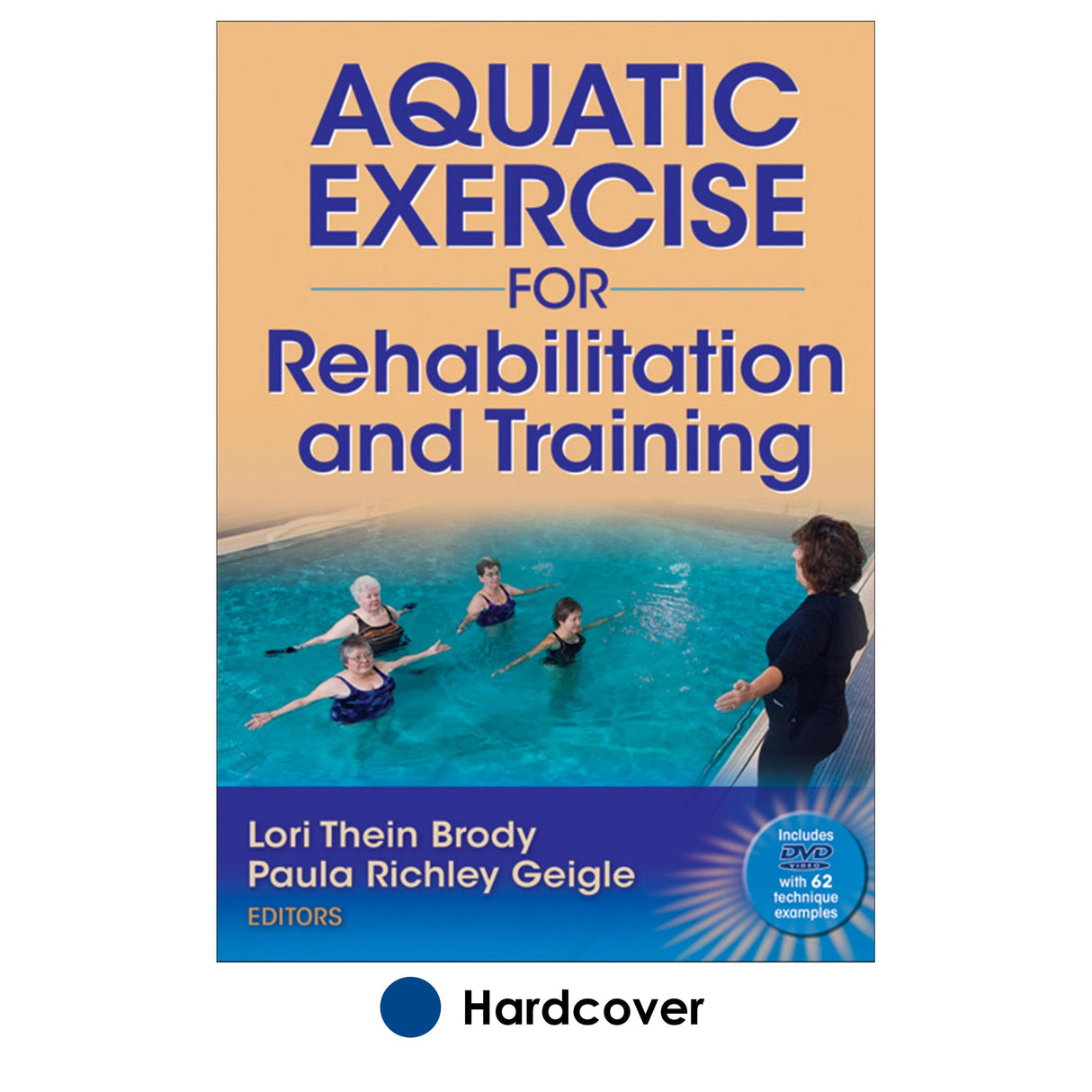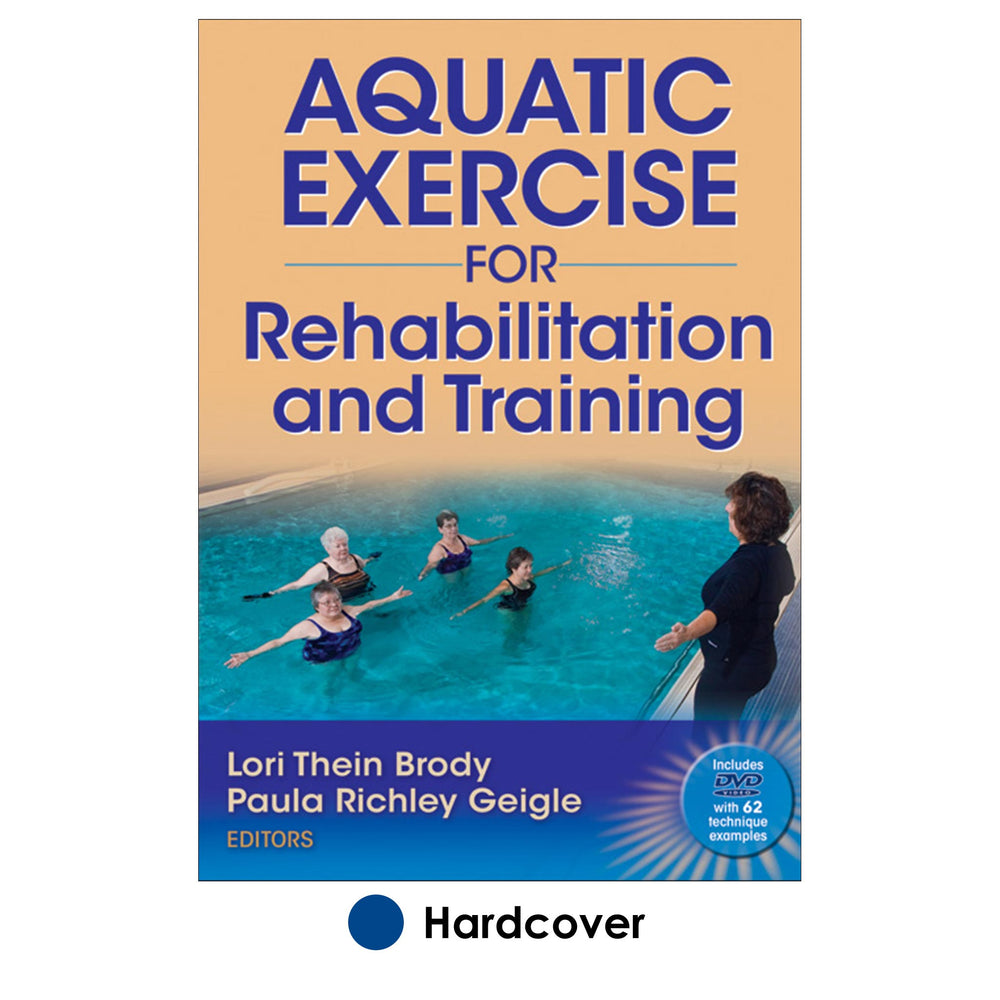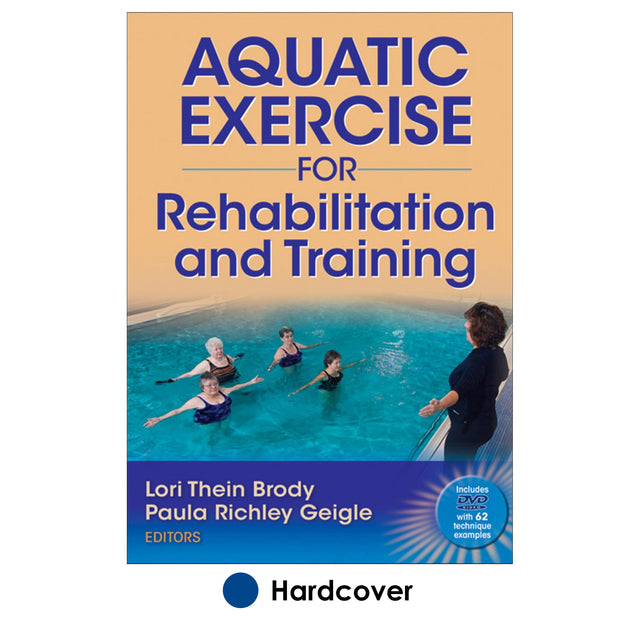Aquatic Exercise for Rehabilitation and Training
Author: Lori Brody, Paula Geigle
$99.00 USD
Prescribing the right aquatic exercise program for those with functional limitations is challenging, in part because the literature on water exercise is limited. That prescription is made all the more difficult when working with clients and patients with a wide range of limitations. Aquatic Exercise for Rehabilitation and Training shows professionals how to design aquatic rehabilitation and exercise programs for various groups and individuals across the life span. The authors guide readers in choosing the right exercises for their clients—including the appropriate exercise frequency, intensity, and duration—based on each client's abilities and limitations.
The authors compiled literature on water exercise from around the world and applied the information to a variety of situations. The book presents several current theories as well as a historical view for each theory and description of treatment implementation. The theories and principles are presented with the use of a regional- and system-based approach. Aquatic Exercise for Rehabilitation and Training also has the following features:
-Descriptions of the physiological responses—including those of the pulmonary, renal, musculoskeletal, and neuromuscular systems—to immersion and water exercise, preparing clinicians for how the body reacts to an aquatic environment
-Indications and contraindications for participation in water programs, providing an understanding of how the physical properties of water and exercise combine advantageously
-Descriptions of the responsibilities of various aquatic team members and patient management across the full spectrum of care
Aquatic Exercise for Rehabilitation and Training is liberally illustrated and comes with a DVD that demonstrates nearly half of the book's exercises and highlights key points for each. The DVD also contains printable evaluation sheets that will help you identify your clients' needs, evaluate specific therapies based on those needs, and choose the best therapies for your clients.
Using case studies as examples, Aquatic Exercise for Rehabilitation and Training presents current concepts, explains how to apply them, and assists readers in determining optimal intervention plans for each client. The text covers the gamut of aquatic exercise for rehabilitation and training, addressing all populations and ages. The authors provide information for adapting programs for various clientele: injured athletes, older adults, and people with special exercise needs, such as patients with cerebral palsy, brain injury and stroke, multiple sclerosis, and rheumatoid arthritis.
Use Aquatic Exercise for Rehabilitation and Training with confidence as you design exercise programs for your clients. Learn how to assess your clients' needs, provide specialized training for various populations, and prescribe neuromuscular training, core musculoskeletal training, and upper- and lower-quarter musculoskeletal training. This book and DVD is a valuable resource, no matter who your clients are, as you help them rehabilitate and train in water.
Audience
Reference for physical therapists, physical therapy assistants, occupational therapists, and athletic trainers. Also a reference for specialists in aquatics, fitness, and general rehabilitation.
Chapter 1. Introduction and Historical Overview
Lori Thein Brody, PT, PhD, and Jean Irion, PT, EdD, SCS, ATC
History of Aquatic Healing and Rituals
Modern Origins of Aquatic Therapy
Current Status of Aquatic Rehabilitation
Indications and Advantages of an Aquatic-Based Program
Contraindications and Precautions for an Aquatic-Based Program
Aquatics programs
Summary
References
Chapter 2. Aquatic Service Providers
Charlotte Norton, DPT, MS, ATC, CSCS, and Lynette Jamison, MOT, OTR/L, CPO
Lyton Model for the Aquatic Team
Licensure, Registration, Certification and Title Acts
Function of Each Team Member in the Aquatic Continuum
Summary
References
Chapter 3. Aquatic Properties and Therapeutic Interventions
Jean M. Irion, PT, EdD, SCS, ATC
Physical Properties of Water
Fluid Dynamic Properties of Water
Summary
References
Chapter 4. Physiological Responses to Immersion and Aquatic Exercise
Dawn T. Gulick, PT, PhD, ATC, CSCS, and Paula Richley Geigle, PT, PhD
Pulmonary System
Renal System
Musculoskeletal System
Neuromuscular System
Summary
References
Part II. Method Elements
Chapter 5. The Halliwick Concept
Johan Lambeck, PT, and Urs N.Gamper, PT
Historical Overview
Treatment Classification
Halliwick and ICF
Learning Stages
Function Level Applications
Activity Level Applications
Participation Level Applications
Specific Skill Training
Summary
References
Chapter 6. The Bad Ragaz Ring Method
Urs N. Gamper, PT, and Johan Lambeck, PT
Physiotherapeutic and Mechanical Principles
Proprioceptive Neuromuscular Facilitation
Indications
Treatment Goals
Application of Techniques
Treatment Time
Exercise Progression
Movement Patterns
Patterns of the Lower Extremities
Patterns of the Trunk
Patterns of the Upper Extremities
Summary
References
Chapter 7. Ai Chi
Ruth Sova, MS, ATRIC
Historical Overview
Breathing Patterns
Movement Principles
Stance and Movement Patterns
Ai Chi Benefits
Applications in Patient Populations
Summary
References
Chapter 8. Watsu
Lynette Jamison, MOT, OTR/L, CPO
History and Philosophy
Treatment Progression
Training and Certification
Physiological Effects
Psychological Effects
Treatment Applications
Precautions and Contraindications
Summary
References
Chapter 9. Swim Stroke Training and Modification for Rehabilitation
Emily Dunlap, PT
Swim Training in an Aquatic Therapy Treatment Plan
Swim Training Progression
Recovery Skills
Static Floating Control
Basic Water Safety Skills
Swim Training Equipment
Swim Strokes and Modification
Injury Modifications
Summary
References
Part III. Client Elements
Chapter 10. Assessment and Evaluation
Paula Richley Geigle, PT, PhD
Clinical Decision Making
Initial Assessment and Evaluation
Medical Clearance
Informed Consent
Water Safety Screening
Vital Sign Baseline Data
Documenting Aquatic Programming and Progression
Discharge from Aquatic Programming
Summary
References
Chapter 11. Specialized Aquatic Cardiovascular Training
Dawn T. Gulick PT, PhD, ATC, CSCS
Monitoring Cardiovascular Performance
Cerebral Palsy
Brain Injury & Stroke
Multiple Sclerosis
Rheumatoid Arthritis
Pregnancy
Cardiopulmonary Disease
Fibromyalgia
Obesity
Older Populations
Injured Athletes
Summary
References
Chapter 12. Neuromuscular Training
David M. Morris PT, PhD, and Paula Richley Geigle, PT, PhD
Rehabilitation of Individuals with Neurological Disorders
General Guidelines for Treatment Design
Aquatic Techniques for Neurorehabilitation Application
Balance and Postural Control
Aquatic Wellness Programs
Summary
References
Chapter 13. Core Muscloskeletal Training
Lori Thein Brody, PT, PhD
Functional Anatomy
Activities to Improve Mobility
Activities to Increase Muscle Performance
Core Emphasis Cardiorespiratory Training
Specific Exercise Recommendations
Summary
References
Chapter 14. Upper Quarter Musculoskeletal Training
Lori Thein Brody, PT, PhD
Functional Anatomy
Indications for Aquatic Therapy
Activities to Improve Mobility
Activities to Improve Muscle Performance
Upper Quarter Focus Cardiorespiratory Training
Specific Exercise Recommendations
Summary
References
Chapter 15. Lower Quarter Musculoskeletal Training
Lori Thein Brody, PT, PhD
Functional Anatomy
Indications for Aquatic Therapy
Activities to Increase Mobility
Activities to Improve Muscle Performance
Cardiorespiratory Training with a Lower Extremity Emphasis
Specific Exercise Progressions
Summary
References
Chapter 16. Case Scenarios of Individuals with Specific Needs
Paula Richley Geigle, PT, PhD
Post Traumatic Brain Injury and Post Partum Depression
Child with Spina Bifida
Cerebral Palsy with Femur Fracture
Lori Thein Brody, PT, PhD, SCS, ATC, is a senior physical therapist in Madison, Wisconsin. Her aquatic therapy experience includes nearly 20 years of treating a variety of patients. Brody is a frequent contributor to the body of knowledge in rehabilitation, including a popular text on therapeutic exercise, teaching continuing education courses, and providing postprofessional coursework.
Brody received the Ron Peyton Award in 2006 for sports physical therapy. In her leisure time, she enjoys swimming, running, biking, and snowshoeing.
Paula Richley Geigle, PT, PhD, is an assistant professor in the department of physical therapy and rehabilitation science at the University of Maryland School of Medicine. Geigle's 27 years of clinical practice as a generalist includes aquatic intervention. Part of her research agenda focuses on incorporating aquatic exercise to manage the negative health outcomes of cancer and aging.
Geigle is past president of the Aquatic Physical Therapy Section of the American Physical Therapy Association (APTA) and served as coeditor of the Journal of Aquatic Physical Therapy. She received the Outstanding Research Award in 2006 from the Aquatic Physical Therapy Section of the APTA. In her spare time she plays tennis, hikes with her golden retrievers, and reads.





